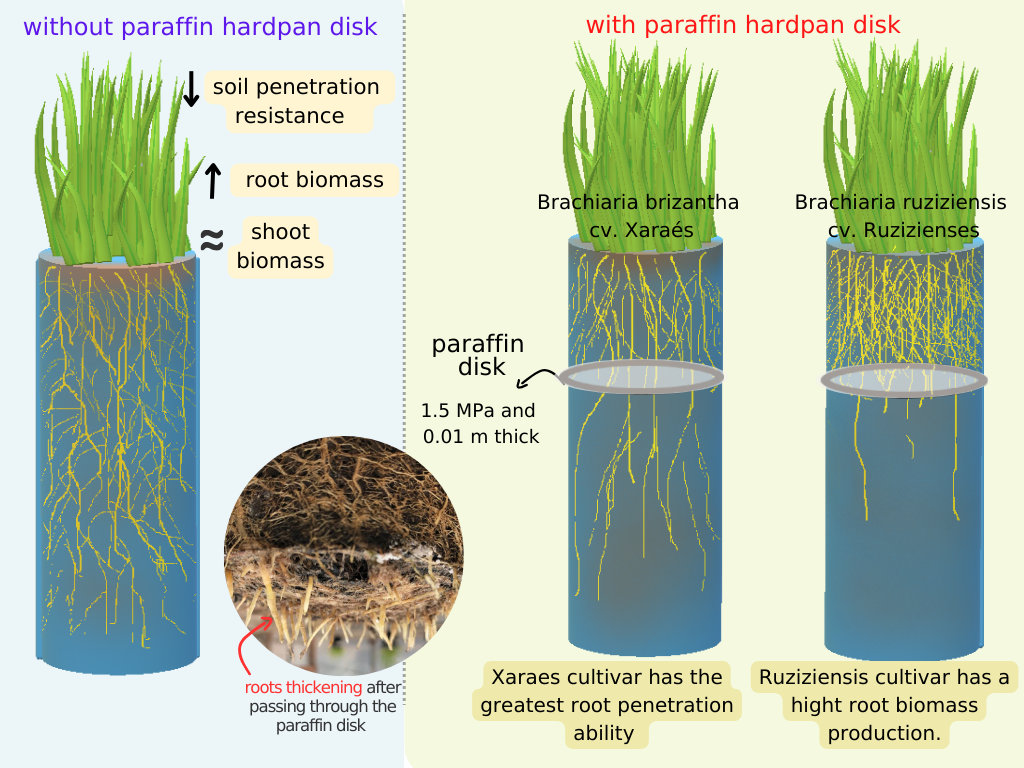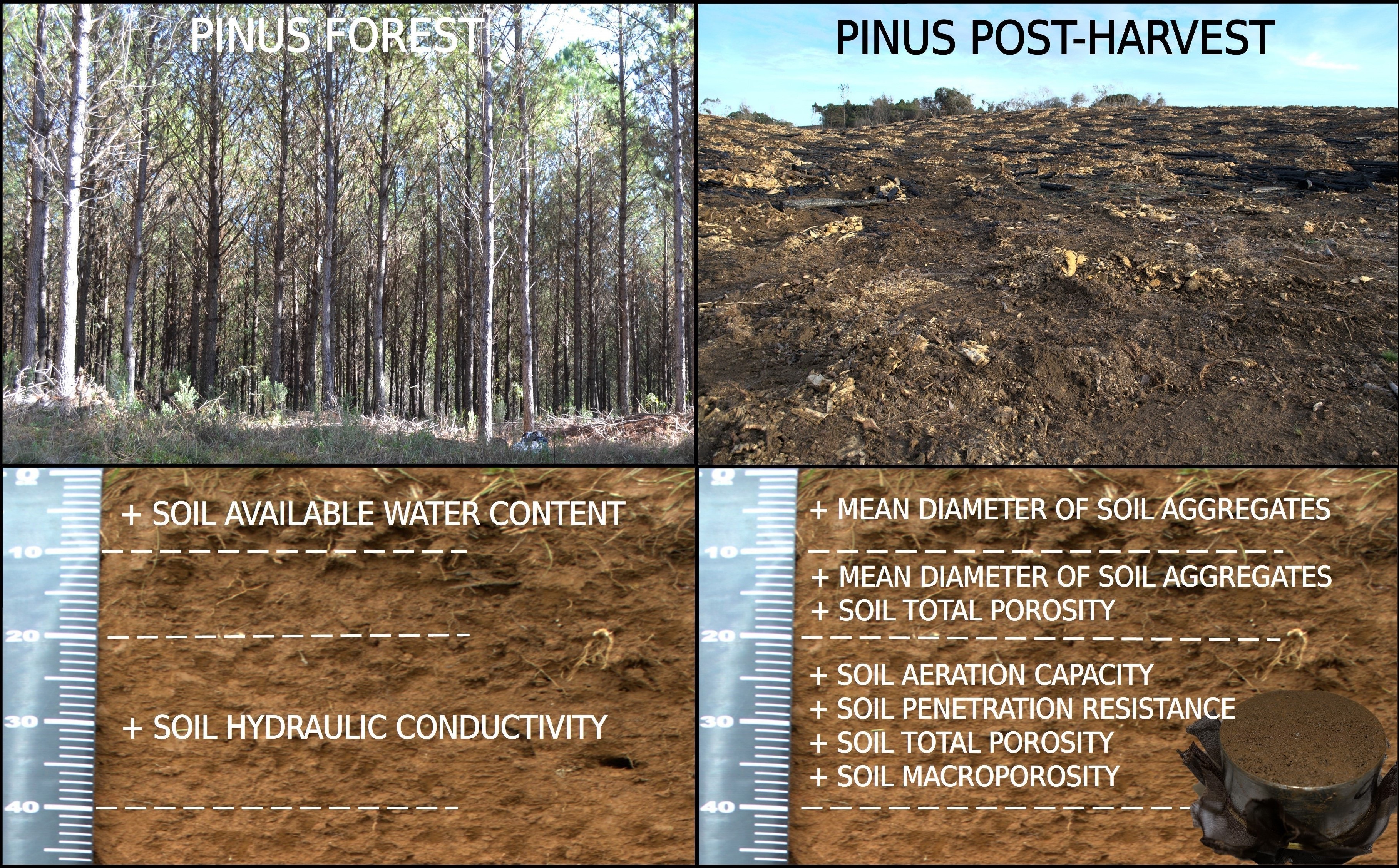Biopores, soil decompacting potential, and biomass of Brachiaria cultivars
07/Mar/2025
ABSTRACT Grasses of the Brachiaria genus are widely used as cover crops in no-tillage areas of the Brazilian Cerrado. This study aimed to evaluate the ability of six Brachiaria cultivars to produce shoot and root biomass, and the potential of the root system to grow through a 0.01 m thick wax layer with 1.5 MPa penetration resistance. The plants were grown in PVC columns with a diameter of 0.1 m and a height of 0.7 m. The column was divided […]
Mechanized harvesting of a Pinus taeda L. forest does not impair the physical properties of a Nitossolo Bruno
10/Feb/2025
ABSTRACT Santa Catarina State, in the South region of Brazil, has 713 thousand hectares of pine forests. Harvesting operations of this species can degrade the soil, especially when carried out on very wet soil. However, there is little information on the impact of pine harvesting on the physical properties of the soil in this region. This study aimed to evaluate the impact of Pinus taeda L. harvesting on the physical properties of a Nitossolo Bruno distrófico típico. Two areas were […]
EUCALYPTUS PRODUCTIVITY, SOIL PHYSICAL PROPERTIES AND ORGANIC MATTER FRACTIONS INFLUENCED BY TRAFFIC INTENSITY AND HARVEST RESIDUES
01/Jul/2015
The number of machine passes, types of wheels, and high soil moisture during harvest operations affect the soil compaction process. The impacts of these factors and alternatives to reduce them must be better understood. This study evaluated the impact of different traffic intensities of a loaded forwarder and the effect of different management conditions of eucalyptus harvest residues on productivity, soil physical properties, and organic matter at the end of the subsequent rotation in two Oxisols in the State of […]
Soil use and physical-mechanical properties of a Red Oxisol
01/Apr/2014
Soil tillage, machine traffic and animal trampling in unsuitable wet soil conditions (consistency in the plastic state) cause plastic and non-recoverable deformations in the soil. The aim of this study was to determine and evaluate the soil physical and mechanical properties to characterize the level of soil compaction and load bearing capacity in three areas with different land uses (rotational grazing, native forest and conventional tillage). Undisturbed soil samples were collected in layers from 0.00-0.05, 0.05-0.10 and 0.10-0.15 m, with […]
Soil physical properties and maize root growth in an ultisol under controlled machine traffic
01/Oct/2013
Soil functions can be hampered by compaction induced by inadequate management. Some soil physical properties are indicators of the existence of compacted layers that can affect the root development of crops. Agricultural practices, e.g., planting of cover crops to improve soil properties, can mitigate the compaction-related problems. The aim of this study was to evaluate the physical attributes of soil and plants, grown under controlled conditions. In an Ultisol under no-tillage with two winter cover crops (fallow and oat + […]
Mineralogy of the clay fraction of alfisols in two slope curvatures. IV – spatial correlation with physical properties
01/Apr/2013
Although the influence of clay mineralogy on soil physical properties has been widely studied, spatial relationships between these features in Alfisols have rarely been examined. The purpose of this work was to relate the clay minerals and physical properties of an Alfisol of sandstone origin in two slope curvatures. The crystallographic properties such as mean crystallite size (MCS) and width at half height (WHH) of hematite, goethite, kaolinite and gibbsite; contents of hematite and goethite; aluminium substitution (AS) and specific […]
Soil physical properties and growth of sweet potato under different soil managements
01/Feb/2013
Studies about reduced tillage in soil cultivated with roots and tubers are rare and controversial. Thus, this study assessed the impact of tillage systems on physical properties of an Alfissol and on the growth of sweet potato tubers. To evaluate the soil physical properties, an experiment was conducted in a randomized block, split-plot design. The plots consisted of the treatments conventional tillage with mounds and reduced tillage with straw on the soil surface and the subplots of two sampling periods: […]
Portable penetrometer for agricultural soil: sensitivity test to identify critical compaction depth
01/Dec/2010
To express the negative effects of soil compaction, some researchers use critical values for soil mechanical strength that severely impair plant growth. The aim of this study was to identify this critical compaction depth, to test the functionality of a new, portable penetrometer developed from a spring dynamometer, and compare it to an electronic penetrometer traditionally used in compaction studies of agricultural soils. Three soils with distinct texture were conventionally tilled using a disk plow, and cultivated with different plant […]
Least limiting water range of a dystroferric red latosol under no-tillage in an integrated crop-livestock system
01/Oct/2010
The least limiting water range (LLWR) is considered a modern indicator of soil physical quality for plant growth. The aim of this study was to determine the LLWR for assessing the soil physical quality of a dystroferric Red Latosol (Oxisol) under no-tillage in a crop-livestock integration system. In the crop-livestock integration system of the study area, soybean was planted in the summer and oat (Avena strigosa Schreb) plus ryegrass (Lolium multiflorum Lam) in the winter with different pasture heights during […]
Water infiltration in soil as influenced by chiseling and crop rotations
01/Jun/2010
In soils with physical and/or physical hydric restrictions for root growth, it may be a viable strategy to increase crop productivity by increasing water storage potential through improvements in water infiltration. Accordingly, the objective of this study was to determine water infiltration in a Hapludult in three crop rotations under no-tillage, with and without initial chiseling. Crop rotations consisted of: millet/soybean/sorghum/maize/sorghum; millet/soybean/Brachiaria ruziziensis/corn/Brachiaria ruziziensis; and millet/soybean/Brachiaria ruziziensis + castor bean/corn/Brachiaria ruziziensis + castor bean. Water infiltration in soil was evaluated […]


